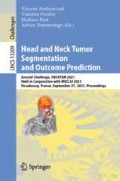Abstract
We present our contribution to the HECKTOR 2021 challenge. We created a Survival Random Forest model based on clinical features, and a few radiomics features that have been extracted with and without using the given tumor masks, for Task 3 and Task 2 of the challenge, respectively. To decide on which radiomics features to include into the model, we proceeded both to automatic feature selection, using several established methods, and to literature review of radiomics approaches for similar tasks. Our best performing model includes one feature selected from the literature (Metabolic Tumor Volume derived from the FDG-PET image), one via stability selection (Inverse Variance of the Gray Level Co-occurrence Matrix of the CT image), and one selected via permutation-based feature importance (Tumor Sphericity). This hybrid approach turns-out to be more robust to overfitting than models based on automatic feature selection. We also show that simple ROI definition for the radiomics features, derived by thresholding the Standard Uptake Value in the FDG-PET images, outperforms the given expert tumor delineation in our case.
S. Starke, D. Thalmeier, P. Steinbach and M. Piraud—Contributed equally to this work.
Access this chapter
Tax calculation will be finalised at checkout
Purchases are for personal use only
References
Andrearczyk, V., et al.: Overview of the HECKTOR challenge at MICCAI 2021: automatic head and neck tumor segmentation and outcome prediction in PET/CT images. In: Andrearczyk, V., Oreiller, V., Hatt, M., Depeursinge, A. (eds.) HECKTOR 2021. LNCS, vol. 13209, pp. 1–37. Springer, Cham (2022)
Andrearczyk, V., et al.: Automatic segmentation of head and neck tumors and nodal metastases in PET-CT scans. In: Medical Imaging with Deep Learning, pp. 33–43. PMLR (2020)
Baumann, M., et al.: Radiation oncology in the era of precision medicine. Nat. Rev. Cancer 16(4), 234–249 (2016)
Bogowicz, M., et al.: Comparison of PET and CT radiomics for prediction of local tumor control in head and neck squamous cell carcinoma. Acta Oncol. 56(11), 1531–1536 (2017). pMID: 28820287. https://doi.org/10.1080/0284186X.2017.1346382
Breiman, L.: Random forests. Mach. Learn. 45(1), 5–32 (2001)
Castelli, J., et al.: A PET-based nomogram for oropharyngeal cancers. Eur. J. Cancer 75, 222–230 (2017)
Im, H.J., Bradshaw, T., Solaiyappan, M., Cho, S.Y.: Current methods to define metabolic tumor volume in positron emission tomography: which one is better? Nucl. Med. Mol. Imaging 52(1), 5–15 (2018)
Ishwaran, H., Kogalur, U.B., Blackstone, E.H., Lauer, M.S.: Random survival forests. Ann. Appl. Stat. 2(3), 841–860 (2008). https://doi.org/10.1214/08-aoas169
Kocak, B., Ates, E., Durmaz, E.S., Ulusan, M.B., Kilickesmez, O.: Influence of segmentation margin on machine learning-based high-dimensional quantitative CT texture analysis: a reproducibility study on renal clear cell carcinomas. Eur. Radiol. 29(9), 4765–4775 (2019)
Leseur, J., et al.: Pre-and per-treatment 18F-FDG PET/CT parameters to predict recurrence and survival in cervical cancer. Radiother. Oncol. 120(3), 512–518 (2016)
Lundberg, S.M., Lee, S.I.: A unified approach to interpreting model predictions. In: Guyon, I., et al. (eds.) Advances in Neural Information Processing Systems 30, pp. 4765–4774. Curran Associates, Inc. (2017). http://papers.nips.cc/paper/7062-a-unified-approach-to-interpreting-model-predictions.pdf
Meinshausen, N., Bühlmann, P.: Stability selection. J. Roy. Stat. Soc. Ser. B (Stat. Methodol.) 72(4), 417–473 (2010)
Oreiller, V., et al.: Head and neck tumor segmentation in PET/CT: the HECKTOR challenge. Med. Image Anal. 77, 102336 (2021)
Paidpally, V., Chirindel, A., Lam, S., Agrawal, N., Quon, H., Subramaniam, R.M.: FDG-PET/CT imaging biomarkers in head and neck squamous cell carcinoma. Imaging Med. 4(6), 633 (2012)
Pedregosa, F., et al.: scikit-learn: machine learning in Python. J. Mach. Learn. Res. 12, 2825–2830 (2011)
Pölsterl, S.: scikit-survival: a library for time-to-event analysis built on top of scikit-learn. J. Mach. Learn. Res. 21(212), 1–6 (2020). http://jmlr.org/papers/v21/20-729.html
Pulte, D., Brenner, H.: Changes in survival in head and neck cancers in the late 20th and early 21st century: a period analysis. Oncologist 15(9), 994 (2010)
Sabatini, M.E., Chiocca, S.: Human papillomavirus as a driver of head and neck cancers. Br. J. Cancer 122(3), 306–314 (2020)
Vallieres, M., et al.: Radiomics strategies for risk assessment of tumour failure in head-and-neck cancer. Sci. Rep. 7(1), 1–14 (2017)
Van Griethuysen, J.J., et al.: Computational radiomics system to decode the radiographic phenotype. Can. Res. 77(21), e104–e107 (2017)
Xie, H., Zhang, X., Ma, S., Liu, Y., Wang, X.: Preoperative differentiation of uterine sarcoma from leiomyoma: comparison of three models based on different segmentation volumes using radiomics. Mol. Imag. Biol. 21(6), 1157–1164 (2019)
Author information
Authors and Affiliations
Corresponding author
Editor information
Editors and Affiliations
Rights and permissions
Copyright information
© 2022 Springer Nature Switzerland AG
About this paper
Cite this paper
Starke, S., Thalmeier, D., Steinbach, P., Piraud, M. (2022). A Hybrid Radiomics Approach to Modeling Progression-Free Survival in Head and Neck Cancers. In: Andrearczyk, V., Oreiller, V., Hatt, M., Depeursinge, A. (eds) Head and Neck Tumor Segmentation and Outcome Prediction. HECKTOR 2021. Lecture Notes in Computer Science, vol 13209. Springer, Cham. https://doi.org/10.1007/978-3-030-98253-9_25
Download citation
DOI: https://doi.org/10.1007/978-3-030-98253-9_25
Published:
Publisher Name: Springer, Cham
Print ISBN: 978-3-030-98252-2
Online ISBN: 978-3-030-98253-9
eBook Packages: Computer ScienceComputer Science (R0)


